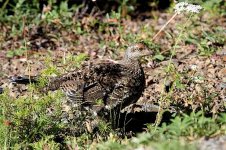wilfredsdad
Well-known member
Hi
I just moved to Canon from Olympus. I have a 500D and a Canon EF400 f5.6 USM - I can only say that so far I have been totally knocked out with both lens and Camera. My comments would be:
1)I don't see a lot of point in using a Zoom lens for bird photography because I think that for 90% of the time you will be using it at it's longest focal length anyway so why suffer the inevitable loss of both optical quality and speed as compared to a fixed focal length lens?
2)I endorse everything said above (and in other threads on the Canon forum) about the EF 400 f5.6 USM - it focuses at lightening speed (even in moderate light conditions) - the focus is accurate, also it returns lovely sharp shots with lovely soft and smooth background blur. It really is a super lens for the money and is very well suited to bird photography.
3)I don't really see much value for image stabilisation in bird photography because virtually every shot requires high shutter speed (to avoid subject motion blur) and therefore camera shake is not much of an issue. Better to spend the money on a good tripod and head - I use a tripod all the time - my arm and wrist quickly begin to tire otherwise and I have not found it much more hassle to cart around a camera on a tripod (although I admit I use a carbon fibre one - worth every penny) than it is to cart around a camera with a telephoto lens on it
4)After a lot of good advice and support from various members on this forum I purchased a Kenko 1.5x teleconverter and I have found it works fine with my camera and lens - as long as the light is not poor. It gives me some very usable extra reach - it's particularly useful for wildfowl on open water and waders on mudflats and sandbanks
5)If you do go for a tripod - get a good one and a good head - I wasted money on two cheap ones before I learned my lesson - a good tripod and head make a massive difference.
6)Finally - be prepared for a fair bit of disappointment at the beginning - and remember that no matter how good your kit you still have to use a lot of patience and ingenuity to get near enough to birds to get decent shots. For woodland birds I have found a bit of camouflage net really does work: find a bit of coppice or trees by water or a muddy scrape, settle down under your camo net and sit and wait - usually something interesting turns up sooner or later - hopefully before you succumb to hypothermia or terminal cramp!
That's my two pence worth - hope it helps, regards Pete
I just moved to Canon from Olympus. I have a 500D and a Canon EF400 f5.6 USM - I can only say that so far I have been totally knocked out with both lens and Camera. My comments would be:
1)I don't see a lot of point in using a Zoom lens for bird photography because I think that for 90% of the time you will be using it at it's longest focal length anyway so why suffer the inevitable loss of both optical quality and speed as compared to a fixed focal length lens?
2)I endorse everything said above (and in other threads on the Canon forum) about the EF 400 f5.6 USM - it focuses at lightening speed (even in moderate light conditions) - the focus is accurate, also it returns lovely sharp shots with lovely soft and smooth background blur. It really is a super lens for the money and is very well suited to bird photography.
3)I don't really see much value for image stabilisation in bird photography because virtually every shot requires high shutter speed (to avoid subject motion blur) and therefore camera shake is not much of an issue. Better to spend the money on a good tripod and head - I use a tripod all the time - my arm and wrist quickly begin to tire otherwise and I have not found it much more hassle to cart around a camera on a tripod (although I admit I use a carbon fibre one - worth every penny) than it is to cart around a camera with a telephoto lens on it
4)After a lot of good advice and support from various members on this forum I purchased a Kenko 1.5x teleconverter and I have found it works fine with my camera and lens - as long as the light is not poor. It gives me some very usable extra reach - it's particularly useful for wildfowl on open water and waders on mudflats and sandbanks
5)If you do go for a tripod - get a good one and a good head - I wasted money on two cheap ones before I learned my lesson - a good tripod and head make a massive difference.
6)Finally - be prepared for a fair bit of disappointment at the beginning - and remember that no matter how good your kit you still have to use a lot of patience and ingenuity to get near enough to birds to get decent shots. For woodland birds I have found a bit of camouflage net really does work: find a bit of coppice or trees by water or a muddy scrape, settle down under your camo net and sit and wait - usually something interesting turns up sooner or later - hopefully before you succumb to hypothermia or terminal cramp!
That's my two pence worth - hope it helps, regards Pete
Last edited:







